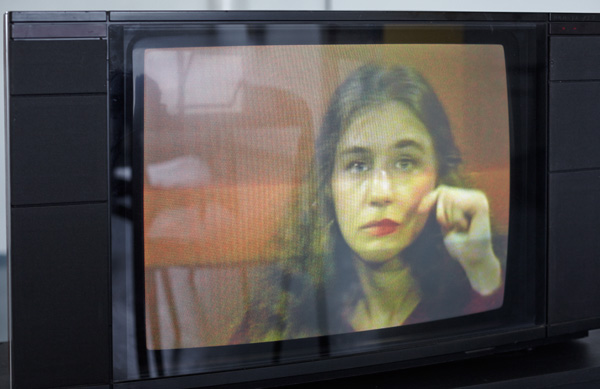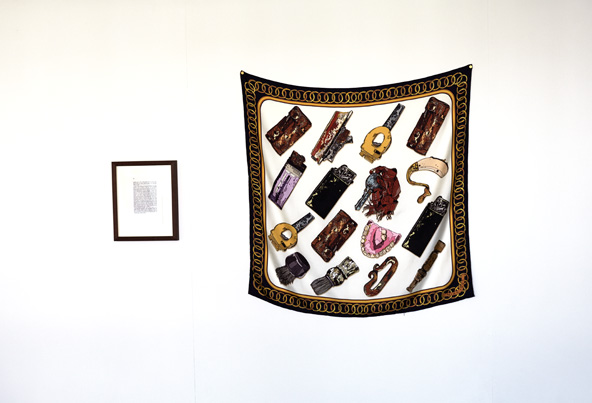
From the Archives
Reading Vogue, 2013
Remarks
For this edition of From the Archives we have travelled back in time all the way to May 2013 and SixtyEight's first exhibition space in the Amager East area of Copenhagen, to take a look at the exhibition Reading Vogue, curated by guest curator Line Ellegaard.
Firstly, we would like to take the opportunity to congratulate Pio Abad, whose work Mira V was featured in the show, on his nomination for the Turner Prize 2024! He has been shortlisted for "his solo exhibition To Those Sitting in Darkness at the Ashmolean Museum, Oxford. Abad’s work considers cultural loss and colonial histories, often reflecting on his upbringing in the Philippines. ... The jury commended the precision and elegance with which Abad combines research with new artistic work to ask questions of museums. They also remarked on both the sensitivity and clarity with which he brings history into the present."
Secondly, it seems clear that many of the exhibition's themes, such as the myths and realities of contemporary culture, the relationship between aesthetics and war, the divide between rural nature and the metropolitan identity of art, the role of the fashion industry in the production of the image of the self, and the status of artistic and cultural appropriation, are no less relevant than they were in 2013, or even in 1982 when Martha Rosler made the work that inspired the exhibition. At the same time, these themes will undoubtedly be viewed differently now than they were just over 10 years ago, given the rapid changes in society in that short time, such as the continuing march of globalisation, the algorithmic influence of social media, the unchecked worsening of the climate crisis, and the emergence of a general understanding that we find ourselves in the midst of a 'polycrisis' of climate change, the environment and biodiversity, mental health, the global economic system, social inequality, and armed conflict.
We therefore present below the curatorial text that accompanied the exhibition as a handout, and a link to the presentation of the exhibition in our exhibition archives.
- SixtyEight


Reading Vogue: About the artists and artworks
The exhibition is centred on and inspired by Martha Rosler’s video work Martha Rosler Reads Vogue, originally a live performance for Paper Tiger Television’s public-access cable programme in New York in 1982. Rosler deconstructs the messages in Vogue magazine and its advertising and looks at the institutional slants of the magazine industry and the fashion industry’s reliance on sweatshops.
Martha Rosler was born in Brooklyn, New York, where she lives and works. She received a B.A. from Brooklyn College and an M.F.A. from the University of California, San Diego. She has taught at the Städelschule in Frankfurt and at Rutgers University in New Jersey. Her works in several media are in the permanent collections of numerous museums. In her work in video, photo-text, performance, critical writing and installation, Rosler constructs incisive social and political analyses of the myths and realities of contemporary culture. Articulated with deadpan wit, Rosler's video works investigate how socioeconomic realities and political ideologies dominate ordinary life. Presenting astute critical analyses in accessible forms, Rosler's inquiries range from questions of public space to issues of war, women's experiences, and media information.
The work of Pio Abad similarly points to the intersection of fashion and politics. In his work objects and images are reconstructed or re-presented in order to activate their relationship to individuals, ideologies and narratives. In Mira V (2012) a page from the diary of Slobodan Milošević’s widow Mira Markovic, is juxtaposed with an imitation Hermes scarf decorated with objects excavated from the Srebrenica genocide of July 1995*. More specifically the objects on the scarf are personal effects excavated from mass graves in Srebrenica, forming part of an archive of objects documented by the Serbian photographer Ziyah Gafic. The text on the wall is a page from Mira Markovic's book Night and Day: A Diary (1996), in which she comments on an article published in Vanity Fair and subsequently republished in the weekly newspaper Duga (Belgrade) in which Markovic, during her husband’s years in power, also had a weekly column.
* The Srebrenica genocide, also known as the Srebrenica Massacre, refers to the July 1995 killing, during the Bosnian War, where more than 8000 people were killed. See http://en.wikipedia.org/wiki/Srebrenica_massacre
Pio Abad was born in Manila, Philippines in 1983. He started his fine art studies at the University of the Philippines and received a BA(Hons) in Painting and Printmaking from Glasgow School of Art and an MA in Fine Art from the Royal Academy Schools. Recent exhibitions include ‘Zabludowicz Invites’, Zabludowicz Collection, 2013; ‘Oh! Oh! Oh! (A Universal History of Infamy)’, PLAZAPLAZA, London, 2012; and ‘London Open’, Whitechapel Gallery, 2012. He was one of the finalists for the Dazed and Confused Emerging Artist Award in 2012. Pio Abad’s work looks at the intersections between histories of the decorative and the political. Through installations, prints and photographs, his work sets up juxtapositions that mine the relationships between things and events, between the anecdotal and the allegorical.
The relationship between aesthetics and war is also explored in the works made by Merete Vyff Slyngborg. With reference to military camouflage patterns, Henri Matisse’s paper cut outs and the aesthetics of a contemporary artist named k. Madison More, Vyff Slyngborg scrutinises the value of taste and aesthetics in a contemporary context. Vyff Slyngborg is interested in how taste and trends are linked not only within contemporary art but also in a broader perspective and how different fields influence each other and thereby create new expressions and ‘stylings’. Such as how fashion has incorporated camouflage to the extent that it no longer necessarily bears connotations related to war and the military. Looking at the continuous change in installation and presentation methods within contemporary art today, one could say these methods change in line with e.g. trends in fashion and Interior Design and vice versa. Vyff Slyngborg’s artwork plays with these shifts and points to the delicate border between good taste and bad taste and the slippage between these categories.
Merete Vyff Slyngborg (b. 1982) studied at the Funen Art Academy and Akademie der Bildenden Künste, Wien, graduating in 2011. Previous exhibitions: ‘Arcadia Missa’, London; ‘Toves Galleri’, Copenhagen; ‘HDTS’, Joshua Tree, California. ‘The Common Place’, Leeds. Upcoming exhibitions include: Grimmuseum, Berlin (June 2013).
English artist Andrew Munks explores a similar territory of taste and style in his work, focusing particularly on British cultural identity and society. In the work Spring (2011) Munks contemplates the divide between the rural nature of his artistic practice and the metropolitan identity of ‘art’. This vision appears just as romantic as it does destructive and absurd. According to the artist ‘the psychology’ of Broadway Market is transplanted to the rural stream as a passageway or catwalk opportunity for the cool kids, hipsters and fashionably attired food-lovers who otherwise parade down the hip London street market. Encapsulated by a ‘yellow brick road’ strewn with dried countryside flowers, it is not simply an analogy of the nostalgia for the simple country life but rather suggests a personal narrative positioning one’s self in the complex and infinite web of material and cultural relationships.
Andrew Munks was born in 1985 in England. He received a BA in Fine Art at the Slade School of Art and recently finished an MA in Fine Art at the Royal College of Art. He is currently enjoying ‘Spring’ and gardening along with looking at what is happening in fashion and London and the waterways of Europe.
Gro Sarauw creates stringent work methods as a basis for provoking nuanced decision-making, rather than avoiding its necessity. She has used this approach to reflect upon particular art histories and protagonists, notably Sturtevant*, which both intrigue and inspire her. If Sturtevant has thrown the concept of originality on its head, Sarauw turns it topsy-turvy once more. Appropriating the image of the mythic artist in Endless Summer 2012, Sarauw reacts against the notion that ‘Sturtevant is the only artist that cannot be copied’. The play of appropriation continues in You Can Ask, (2012), where we hear ‘Sturtevant’ read an email sent to her inviting her to choose the best bust, out of a range of busts, of herself. Lastly, the sculptural work After a Man’s Woman (2012) elaborates on this narrative in a poetic and subtle way.
* Elaine Sturtevant is an American artist (b.1930) known for her manual reproductions of painting and objects made by her contemporaries, such as Warhol, Duchamp and more recently Jeff Koons.
Sarauw’s work is developed through highly determined strategies and methods of researching and making. Most recently Sarauw was selected for ‘The Spring Exhibition 2013’ at Kunsthal Charlottenborg, Copenhagen. In 2014 she will graduate from Goldsmiths University, London with an MFA in Fine Art.
In the work of Paul Kindersley it is the appropriation, not of works of art or artists, but cultural and gender norms which are jumbled up. His makeup videos, part of a series of YouTube videos, channel the language of fashion magazines and women’s beauty advice. These absurd videos, part camp, part un-muted Bruce Nauman Art-makeup video, straddle the difficult balance between seduction and subversion in reference to culture, politics, art and ‘everyday survival’.
Paul Kindersley is an artist, stalker, makeup enthusiast and pervert who graduated from Chelsea College of Art in 2009.
Finally, Urara Tsuchiya’s practise also involves the styling and transformation of the self through make-up and disguise; her work includes creating performances, videos, and live events. She often incorporates soft sculptures, costumes, masks, and home cooking. These function as props in an alternate environment that make space for different behaviour, and in this way she explores the disconcertion that can be found between the personal and social worlds. For ‘Reading Vogue’, instead of her usual ‘live’ work, Tsuchiya presents documentation of the performance Stairway to stardom, an insect fashion show made in collaboration with Anna Tanner and Mimei Thompson for ‘you’ve been selected’, Tsuchiya’s recent solo exhibition at the Embassy Gallery in Edinburgh 2012. The ‘look book’ also includes images from a subsequent photo shoot of the artist and her friends dressed as insects. Insect Lookbook (2013) appropriates fashion industry formats, such as the catwalk, the look book and the photo shoot, to explore the binary of animal/human to strange and humorous effect.
Urara Tsuchiya was born and raised in Japan. She completed her BA in Fine Art at Goldsmiths in 2007, and MFA at The Glasgow School of Art in 2012. She currently lives and works in Glasgow. Recent exhibitions include: ‘You have been selected’, solo show at Embassy Gallery, Edinburgh, 2012, ‘Statics’, group exhibition at Transmission, Glasgow, 2013, and ‘Don’t leave me this way’, MFA International Show, Berlin, 2012.
- Line Ellegaard